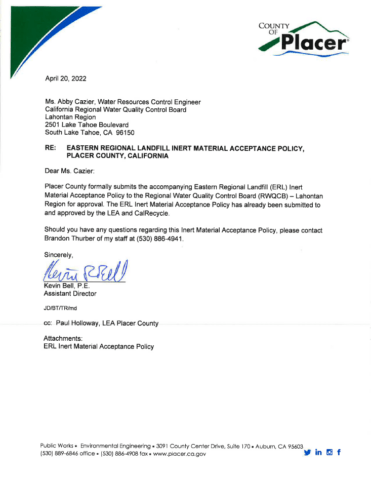Eastern Regional Landfill (ERL) Inert Material Acceptance Policy
> Click Here to Download the PDF form <
Inert Material Control and Acceptance

ERL defines inert materials as materials that are: neither chemically nor biologically reactive, do not contain hazardous waste or soluble pollutants at concentrations in excess of applicable water quality objectives, and do not contain significant quantities of decomposable waste. Material bound for the inert processing area must meet the material acceptance standards outlined below. ERL performs a minimum of two separate load inspections for all inbound inert loads regardless of prior screening. Personnel are trained to perform visual and olfactory load checks to identify any sign of prohibited materials, suspicious labeling, and specific waste generators who have at any time been in violation of this policy. Scale house personnel provide the primary inspection as the material arrives on site. If the material passes inspection, the scale house personnel will direct the load to the inert processing area. While unloading, a secondary inspection will be provided by ERL personnel, a spotter. The spotter has the discretion to stop the customer from unloading if any sign of prohibited material is observed.
In the event that inbound materials violate this policy and are found to be questionable, prohibited, or fail to pass any inspection, ERL reserves the right to reject the load. Scale house personnel will have the discretion to accept loads that contain nonhazardous mixed solid waste and charge an applicable rate. If any prohibited materials are dumped and subsequently identified, ERL will facilitate proper clean-up and bill the responsible party. Alternatively, ERL may request that the generator submit an application for soil acceptance. Sampling and Analysis Requirements
Acceptable Inert Materials
- Clean Soil
Granular soil such as clay, sand, or silt that breaks apart when handled by light duty construction equipment such as a small backhoe or skip loader. No trash, metal, or wood. Less than 10% root grass, and/or wood contamination. Loads with these contaminants will be charged as trash. Loads with excessive rock, concrete, or asphalt will be charged as Mixed Inert as described below. - Clean Rock, Asphalt, or Concrete
Any combination of rock, concrete, gravel, brick, asphalt, or asphalt grindings which is less than 24 inches in any 2 dimensions. Concrete debris should have minimal rebar protruding from the individual pieces of concrete. No trash, excessive metal, wood, roots, or grass contaminants. Loads with these contaminants will be charged as MSW. Loads with soil content greater than 10% will be charged as Mixed Inert as described below. - Mixed Inerts
Any combination of Clean Soil (as described above) and Clean Asphalt/Concrete (as described above). No trash, metal, or wood. Less than 10% root, grass, and/or wood contamination. Loads with contaminants above the 10% threshold will be charged as MSW.
Non-Acceptable Materials
- Hazardous Materials: includes but not limited to: automotive fluids (fuel, antifreeze, oils), paint, lacquer, stain, thinner, varnish, wood preservatives, pesticides, weed killer, and chemicals of any kind.
- Soluble pollutants and water-soluble solids such as salt, borax, lye, caustics/acids.
- Improperly handled waste
- Untreated infectious waste, septic tank, or chemical toilet waste.
- Waste that is composed of greater than 10% woody matter.
- Waste with significant quantities of decomposable waste.
- Overly viscous soil
- Street sweepings
- Radioactive materials
- Mixed Solid Waste (MSW)
- Other prohibited items
For purposes of this Policy, hazardous wastes include, but may not be limited to, wastes listed and/or included in the definitions contained in 40 CFR Part 261 or Title 22 of the California Code of Regulations or defined by Placer County to be hazardous.
Application for Soil Acceptance
ERL may at any time require a generator to submit an application for soil acceptance in order to certify that the material meets minimum acceptance standards. Depending on the origin and environment of the material, soil sampling may be required as part of the application to confirm and certify the absence of prohibited material. Sampling and testing parameters are at the discretion of ERL/County and based on property location and prior use of the site and/or adjacent properties. Any certification must be signed and stamped by either a civil engineer or geologist registered in the State of California. Documentation of the analysis must accompany the certification with sufficient information to assess the potential for the presence of hazardous materials or prohibited composition.
Note that inert materials such as road base, broken or ground asphalt, and broken concrete are acceptable materials, and no special sampling or testing is required. These materials are stockpiled separately in the inert processing area for use onsite or for processing into road base materials for use offsite. While general street sweeping debris are prohibited, sweepings from asphalt pavement grinding operations are acceptable as ground asphalt.
ERL requires a generator to submit an application for soil acceptance when individual project material will exceed a disposal volume of 1,000 cubic yards. Volumes in excess of this amount are specifically subject to Placer County approval, in addition to submission of an application. ERL may also require a separate application submission for ACP and Concrete rubble due to Page 2 capacity limitations. ERL may limit the daily disposal volume of any project or contractor if deemed to be an excessive burden on normal traffic volume and on site capacity. ERL may require contractors to provide traffic directors or spotters in order to alleviate burden to on site personnel. Contractors or project managers are encouraged to call in advance to determine if larger volumes of soil can be brought to the facility as there are capacity limitations for fill material in the reclamation area.
Prohibited Contaminate/Sampling
Provide list of prohibitive contaminates and parameters for testing if needed (heavy metals, gas, diesel, oil, VOC, semi-VOCs, pesticides). Parameters could be source-based as part of application process.